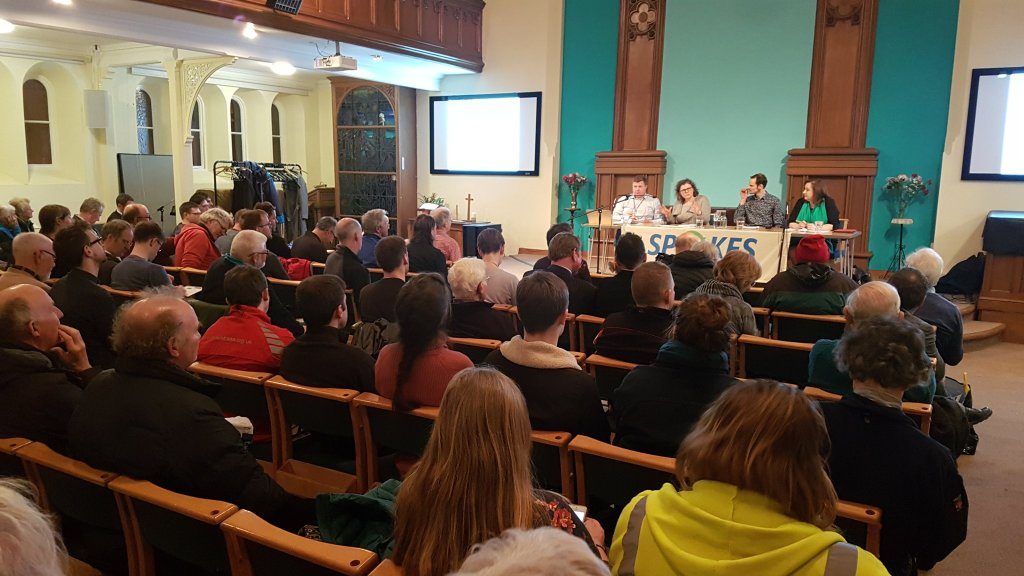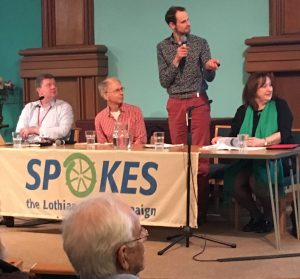1. Stop Press: as we publish this article consultation drawings go on display on the tram extension website.
2. For documents about the tramline extension consultation see our developing tramline extension page.
The proposals in the York Place to Newhaven tram extension consultation are just proposals, and can be changed. But, if they remain, cycleroute provision between Pilrig and Foot of the Walk will be dreadful. These were the two top themes to emerge from our March 15 public meeting on the tram extension.
The Meeting
Our speakers…
- Councillor Lesley Macinnes, Edinburgh City Council Transport Convener, outlined the rationale for the tram extension and restated her desire for Edinburgh to become Europe’s greenest city, with a very high priority for walking and cycling. However, every view must be listened to, and a ‘balanced’ outcome achieved.
- Rob Leech, Project Director for the York Place to Newhaven Tram extension, described the general principles of the project. He also gave a rough outline of the proposed treatment of cycling – whilst repeatedly emphasising that the forthcoming consultation will be ‘genuine,’ albeit there are many different needs to be balanced. Rob’s presentation slides are below, but details of tramline layouts will be in the consultation materials, from March 19th.

- Martyn Lings, Senior Active Travel Officer at the Council outlined the Council’s 4-phase implementation of measures to try and improve safety in the existing tramlines, of which phase 3 is now out for public consultation (slides below).
- Dave du Feu from Spokes gave the background to Edinburgh’s cycle/tram relationship – see below.
- Dr Caroline Brown chaired the 1-hour QA/panel discussion. Whilst the audience was as articulate as ever, considerable frustration was apparent over the consultation proposals as they affect Leith Walk (see below). Many people found it hard to reconcile ‘balance between different interests’ in Leith Walk with the government’s transport hierarchy, the Council’s Local Transport Strategy modal share targets, and its wish to be Europe’s greenest city. In closing, Caroline urged everyone concerned to make their voice heard in the public consultations – see links below.
We were delighted that the audience included 3 councillors…
- David Key (SNP) Council Cycling Champion, and a Spokes member
- Scott Arthur (Lab), Spokes member – who kindly turned up 30 mins early to help on our info stall, and who has also blogged about the meeting
- Alex Staniforth (Green).
- Also in the audience was George Lowder, CEO of Transport for Edinburgh, the overall body for Edinburgh Tram and Lothian Buses.
We very much appreciate these decision-makers coming along, on their own volition, to hear the debate and take away the ideas and concerns of the 100-strong audience.
Main issues at the meeting
Whilst concern over Leith Walk (see below) almost completely dominated the QA, some good points did emerge from the meeting, including…
- North Edinburgh Network – a proper connection will be made to Ocean Terminal. Rob Leech said that the consultation plan is just an initial stab which is too zig-zag and will be refined – ideas will be welcomed in the consultation.
- Cargo Bikes – consideration is being given to using cargo bikes during construction, and also using this to assess their effectiveness for a range of future Council purposes.
- Bike carriage – this will remain on the extended tram, Edinburgh still being the only UK tram operator to carry bikes on regular services. The extended line will enhance the value of this service, for people living, working or visiting in Leith area.
With the tram consultation not launching until Monday 19th, detailed proposals for cycle facilities and routes relating to the tram project were not yet public.
Much of the route north of the Foot of the Walk, we were told, runs in narrow corridors where there is little or no space for cycle routes, and alternatives will need to be found. The impression was given that not much thought had yet been given to such alternatives, and consultation feedback was awaited to help decide on such measures.
Leith Walk future
Rob Leech did, however, outline the consultation proposals for Leith Walk.
As expected, segregated cycle lanes will continue from Pilrig up to Picardy Place, forming part of the West-East route, and with a link up Leith Street (though currently only as far as Calton Road).
Between Pilrig and Foot of the Walk, however, where Leith Walk narrows, the consultation proposal is for onroad painted lanes with loading and parking bays marked in the cycle lanes.
The absence of segregated lanes here dominated the QA session at the meeting.
Between Pilrig and Foot of the Walk there will be 2 traffic lanes in each direction, which the consultation proposes to use as follows…
- Inner Lane (with tramlines) Peak period: tram & bus; Off-peak: all traffic.
- Outer Lane (with cycle lane) Peak: all traffic (no loading or parking); Off-peak: loading & parking in marked sections of the cycle lane.
Thus in the peak cyclists will have an unsegregated onroad traffic lane which should normally be traffic free, but is likely to deter many of those coming from the upper Leith Walk segregated route. Off peak, cyclists will have to move close to the tramline lane to pass parked vehicles and contend with vans and cars moving in and out . This is rather like, but much worse than, the Princes Street layout, where you have to move out to pass parked buses rather than lorries and vans. Yet even in Princes Street, where there are only taxis and buses, tramline crashes occur because of the pressures of traffic moving out, or coming up behind.
There is no way that significant numbers of family cyclists, or new or unconfident cyclists, will use this section. In other words, the Council’s flagship West-East cycleroute becomes a route not to Leith but to Pilrig!! And even for the confident cyclist who does use this section, there will undoubtedly be tramline crashes – just as happens for even the most confident in the existing tram layout.
In our view, segregated cycleroutes must continue throughout Leith Walk if the West-East route is to retain its ‘flagship’ status and if the Council is serious about its own tough modal share targets (for increased cycling and for reduced car use) and its ‘greenest city’ ambition.
There are a range of options which could be considered for achieving this, including removing the central reservation, restrictions on private motor traffic, revised loading arrangements etc. To go ahead with the proposals as they stand is to repeat the mistakes of the first tram installation, deterring many potential cyclists and bringing greater crash likelihood for those who are not deterred.
Background to Spokes and the cycle/tram relationship
- Spokes has always supported the principle of the tram. A pre-tram survey of Spokes members found widespread support, as long as conditions for cycling were not worsened.
- Unfortunately the tramline layout was designed with little attention to cycling, walking or bus integration – the recommendations of a Dutch transport consultant brought over by Spokes and TIE were rejected.
- The tram has brought some specific benefits for cycling. Thanks to the tram, cars were banned from Shandwick Place. Edinburgh is still the only UK tram to allow bike carriage on regular services.
- But the negatives have been huge – over 250 people presenting to A&E departments following tramline bike crashes, a probably tramline-related death, and over 100 legal cases against the Council. Many more people almost certainly deterred from using a bike in the city centre.
- Crashes often occur because traffic pressures force the cyclist into tramlines, including many when cycling parallel to the lines as well as when intending to cross them. The real solution is provision of segregated cycle lanes on main tramline routes, together with opportunities to cross tramlines at a good angle. In addition to Leith Walk, Spokes will be arguing for them in Princes Street as part of the City Centre Transformation project.
- The first meeting of the new Edinburgh Council, on 29 June 2017, passed a motion (9.1) on tramline safety which promised steps to “ensure design of any future tramline extension reflects Council policies to prioritise pedestrian and cyclist safety and convenience, including consideration of segregated cycle lanes.” The proposals out for consultation do not ‘ensure’ this ‘priority.’
- Where segregated lanes do not yet exist (as in the existing layout) Spokes welcomes ameliorative measures as in the Council’s current 4-phase programme, of which Phase 3 is now out for consultation – see below. Frequent tramline crashes at the dreadfully bad initial Haymarket layout were cut drastically merely by moving a taxi rank and installing a prominent cycle lane.
Meeting resources
- Rob Leech presentation [ppt, 12MB]
- Martyn Lings presentation [ppt]
- Notes from QA session
- Blog by Cllr Scott Arthur [link]
- Spokes Bulletin 130 with pre-meeting lead article [pdf]
- Spokes tramline extension documents/links web page
What you can do
- Take part in the tram extension consultation [March 19-April 29] – don’t just leave it to Spokes. Remember – despite best efforts we didn’t manage to get cycling properly handled in the first tram project. It needs everyone concerned to do their bit! If you make an email submission, send us a copy. Also consider speaking to your councillors if this really matters to you. Email them to find their surgery dates or when you can meet them. Find them at www.edinburgh.gov.uk/councillors.
- Take part in the phase 3 Safety Measures consultation for the existing tramlines [March 14 – April 11]. This is a lot quicker and easier than the tramline extension! Spokes supports all the proposals except that we support Option 2, not Option 1, at Haymarket. Option 1 still puts cyclists at risk from motorists turning into Grosvenor Street [a bikecam collision picture is shown in Spokes 130, p7]. It is important to respond as there is opposition to some of the proposals, including to Option 2 above.
